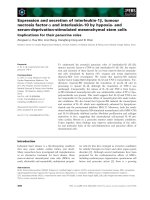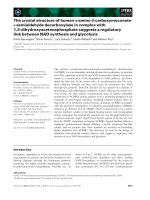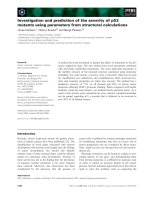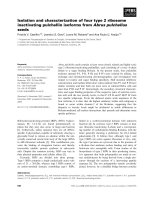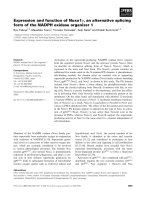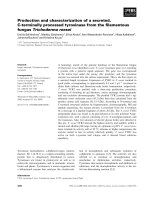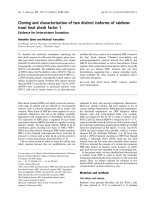Báo cáo khoa học: Folding and turnover of human iron regulatory protein 1 depend on its subcellular localization pdf
Bạn đang xem bản rút gọn của tài liệu. Xem và tải ngay bản đầy đủ của tài liệu tại đây (370.22 KB, 10 trang )
Folding and turnover of human iron regulatory protein 1
depend on its subcellular localization
Alain Martelli
1
,Be
´
ne
´
dicte Salin
2
, Camille Dycke
1
, Mathilde Louwagie
3
, Jean-Pierre Andrieu
4
,
Pierre Richaud
5
and Jean-Marc Moulis
1
1 Laboratoire de Biophysique Mole
´
culaire et Cellulaire (UMR-CNRS 5090 ⁄ Universite
´
Joseph Fourier), CEA-Grenoble, France
2 Institut de Biochimie et Ge
´
ne
´
tique Cellulaires du Centre National de la Recherche Scientifique (UMR-CNRS 5095 ⁄ Universite
´
Victor
Segalen), Bordeaux, France
3 Laboratoire de Chimie des Prote
´
ines (ERIT-M 02–01), CEA-Grenoble, France
4 Institut de Biologie Structurale JP Ebel (CEA ⁄ CNRS ⁄ Universite
´
Joseph Fourier), Grenoble, France
5 Laboratoire des Echanges Membranaires et Signalization (UMR-CNRS 6191 ⁄ Aix-Marseille II), Saint Paul les Durance, France
Aconitases are found in a wide range of living organ-
isms, from bacteria to higher eukaryotes [1]. They are
metalloproteins containing a [4Fe)4S] cluster that
binds citrate or isocitrate and acts as a Lewis acid to
isomerize these substrates. Aconitases catalyse one
reaction of the citric acid cycle and they participate in
supplying the precursors of essential nutrients such as
glutamate. In eukaryotic cells, proteins with aconitase
activity can be found in different compartments, inclu-
ding mitochondria, for the enzymes of the citric acid
cycle, and the cytosol [2]. Deletion of ACO1,
YLR304C, the gene encoding mitochondrial aconitase,
Keywords
aggregation; iron–sulfur cluster biogenesis;
a-ketoglutarate dehydrogenase;
Saccharomyces cerevisiae; translocation
Correspondence
J M. Moulis, CEA-Grenoble, DRDC ⁄ BMC,
17 rue des Martyrs, 38054 Grenoble Cedex
9, France
Tel: +33 4 38 78 56 23
E-mail:
(Received 24 October 2006, revised
4 December 2006, accepted 19 December
2006)
doi:10.1111/j.1742-4658.2007.05657.x
Aconitases are iron–sulfur hydrolyases catalysing the interconversion of cit-
rate and isocitrate in a wide variety of organisms. Eukaryotic aconitases
have been assigned additional roles, as in the case of the metazoan dual
activity cytosolic aconitase–iron regulatory protein 1 (IRP1). This human
protein was produced in yeast mitochondria to probe IRP1 folding in this
organelle where iron–sulfur synthesis originates. The behaviour of human
IRP1 was compared with that of genuine mitochondrial (yeast or human)
aconitases. All enzymes were functional in yeast mitochondria, but IRP1
was found to form dense particles as detected by electron microscopy. MS
analysis of purified inclusion bodies evidenced the presence of human IRP1
and a-ketoglutarate dehydrogenase complex component 1 (KGD1), one of
the subunits of a-ketoglutarate dehydrogenase. KGD1 triggered formation
of the mitochondrial aggregates, because the latter were absent in a
KGD1
–
mutant, but it did not efficiently do so in the cytosol. Despite the
iron-binding capacity of IRP1 and the readily synthesis of iron–sulfur clus-
ters in mitochondria, the dense particles were not iron-rich, as indicated by
elemental analysis of purified mitochondria. The data show that proper
folding of dual activity IRP1-cytosolic aconitase is deficient in mitochon-
dria, in contrast to genuine mitochondrial aconitases. Furthermore, effi-
cient clearance of the aggregated IRP1–KGD1 complex does not occur in
the organelle, which emphasizes the role of molecular interactions in deter-
mining the fate of IRP1. Thus, proper folding of human IRP1 strongly
depends on its cellular environment, in contrast to other members of the
aconitase family.
Abbreviations
hAco2, human mitochondrial aconitase; (h)IRP, (human) iron regulatory protein(s); KGD1, a-ketoglutarate dehydrogenase complex
component 1; m- and c-, location for protein production, mitochondria and cytosol, respectively; yAco1, yeast mitochondrial aconitase.
FEBS Journal 274 (2007) 1083–1092 ª 2007 The Authors Journal compilation ª 2007 FEBS 1083
confers glutamate auxotrophy on Saccharomyces cere-
visiae. Mutant cells cannot grow on nonfermentable
substrates [3]. More recently, mitochondrial aconitase
has been assigned new roles, including the stabilization
of mitochondrial DNA [4].
In mammalian cells, two aconitase paralogs are pre-
sent in the cytosol: iron regulatory proteins 1 and 2
(IRP1 and IRP2). IRP1 and IRP2 are important regu-
lators of cellular iron traffic in metazoans [2]. They
are trans-acting elements that bind to the mRNA of
key proteins involved in the use, storage and transport
of iron in the cell; this translational regulation relies
on the interaction of IRP with specific RNA sites
called iron responsive elements, which are found in the
untranslated sequences of the transcripts. Whereas
IRP2 is not known to display aconitase activity, IRP1
can assemble a [4Fe)4S] cluster to become a functional
cytosolic aconitase while loosing its mRNA-binding
activity. The balance of IRP1 between its iron–sulfur-
containing form and apoprotein is the main process
that controls IRP1 activity as a regulator of cellular
iron management [2]. The importance of the aconitase
activity of IRP1 in the cytosol of mammalian cells
remains to be fully assessed, although roles in the pro-
duction of the precursors of fatty acid b-oxidation or
in the resistance to oxidative stress, by providing the
substrate of isocitrate dehydrogenase and favouring
cytosolic NADPH production, may be proposed.
The similarities between mitochondrial and cytosolic
aconitases of animal cells include the ability to bind
[4Fe)4S] clusters. Iron–sulfur cluster biosynthesis has
recently been the topic of intense interest, particularly
in S. cerevisiae. An extensive set of proteins participa-
ting in different stages of the process has been discov-
ered. More than 10 such proteins have been found in
mitochondria where iron–sulfur cluster synthesis is
believed to begin. Other proteins are also needed in
the cytosol for extra-mitochondrial iron–sulfur proteins
[5]. Metazoan aconitases are of interest in this respect
because they are two homologous proteins that specif-
ically locate to distinct subcellular compartments and
each assembles an iron–sulfur cluster. Furthermore,
accurate structural data are available for prototypes of
both proteins, with models for bovine mitochondrial
[6] and human cytoplasmic [7] aconitases. They show
that these proteins are structurally very similar, and
suggest similar requirements for assembly of the iron–
sulfur units.
It is of interest therefore to know whether the fold-
ing of these two proteins around their iron–sulfur clus-
ter occurs similarly in mitochondria and in the cytosol.
To address this question, human IRP1, yeast mitoch-
ondrial aconitase (yAco1), and human mitochondrial
aconitase (hAco1) were produced either in the cytosol
or in the mitochondria of S. cerevisiae. Whereas tar-
geting of the different aconitases occurred as expected,
ultrastructural analysis combined with proteomic
methods revealed unexpected protein–protein interac-
tions interfering with efficient mitochondrial protein
turnover in the case of human cytosolic aconitase.
These results emphasize specific features of human
IRP1 among aconitases which may be associated with
its exceptional regulatory function among proteins of
the aconitase family.
Results
Human IRP1 displays aconitase activity in yeast
mitochondria
Saccharomyces cerevisiae cells harbouring the different
plasmids were grown with glucose as the carbon
source. In the case of the YEpLmitIRP1 plasmid, the
yeast aconitase presequence was fused to the complete
coding sequence of human IRP1 as a way of translo-
cating the protein to yeast mitochondria. The aconitase
activity of all proteins addressed to mitochondria was
probed by complementation of the glutamate auxotro-
phy exhibited by the ACO1-depleted S. cerevisiae
FYF4-A1 aco1 strain, i.e. cells in which the gene enco-
ding mitochondrial aconitase was deleted. There was
no growth of cells containing the empty vector on a
minimal medium depleted of glutamate, as expected
from the aco1 genotype (Fig. 1, first row). By contrast,
all aconitases directed to yeast mitochondria rescued
the growth deficiency in the absence of glutamate
(Fig. 1). Furthermore, human IRP1 addressed to mito-
chondria was hardly less efficient than genuine mitoch-
ondrial aconitases (from yeast or human, targeted with
its own presequence in the latter case). This indicates
that aconitase activity is present in all strains, inde-
pendent of the origin of the cloned cDNA and whether
the enzymes are naturally located in mitochondria.
However, the data do not demonstrate the proper tar-
geting of the proteins to mitochondria. Therefore,
ultrastructural analysis of these yeast strains was
carried out.
Immunocytochemical and ultrastructural analysis
of mitochondria-targeted IRP1
Saccharomyces cerevisiae W303-1B cells producing
m-hIRP1 were analysed using immunogold electron
microscopy. First, use of the preimmune serum as a
control revealed that there was no nonspecific
staining of these cells (Fig. 2A). However, the presence
Human IRP1 forms aggregates in yeast mitochondria A. Martelli et al.
1084 FEBS Journal 274 (2007) 1083–1092 ª 2007 The Authors Journal compilation ª 2007 FEBS
of electron-dense particles was noted in mitochondria
(Fig. 2). These particles appeared globular in shape,
with an ovoid contour and diameters of 100–500 nm.
They will be referred to as inclusion bodies, aggregates
or dense particles in the following.
The use of polyclonal antibodies recognizing hIRP1
(Fig. 2B,C) resulted in heavy and uniform labelling of
all inclusion bodies, which clearly indicated the associ-
ation of hIRP1 with these particles. The remaining vol-
ume of mitochondria was only faintly labelled with
little evidence of cristae. Outside the mitochondria,
hIRP1 was hardly detected. This demonstrates efficient
mitochondrial addressing of hIRP1 fused to the yeast
mitochondrial aconitase presequence. With raffinose, a
nonexclusively fermentable substrate, dense particles
were even more frequent in the mitochondria than
when glucose was used as a carbon source (Fig. 2C).
Indeed, > 16% of mitochondria contained inclusion
bodies in 25 cells grown on raffinose, whereas this pro-
portion decreased to < 7 in 20 cells grown on glucose.
Mitochondrial inclusion bodies were not detected in
cells producing c-hIRP1, i.e. in which the protein
remained in the cytosol. However, aggregates could
occasionally be visualized in the cytosol of these cells,
whether glucose or raffinose was used as a carbon
source (not shown): a single dense cytosolic particle
was counted in 2 of 150 cells. In these rare cases the
aggregates were systematically and uniformly immuno-
labelled, accounting for the presence of hIRP1.
To ensure that electron-dense particle formation in
mitochondria was not due to a general mitochondrial
defect induced by plasmid-driven aconitase synthesis
and that it was specific to hIRP1 production, we ana-
lysed the same yeast strain expressing either the human
or the yeast mitochondrial aconitase genes (YEp-
Laco2P and YEpLScmaco plasmids, respectively).
Each protein was addressed to yeast mitochondria
under the dependence of its own presequence in other-
wise identical expression conditions. Yeast cells, grown
in glucose at 30 °C, were examined for ultrastructure
using transmission electron microscopy. No electron-
dense mitochondrial materials were observed with
human or yeast mitochondrial aconitases (Fig. 3), indi-
cating that the inclusion bodies (Fig. 2) were specific
Fig. 1. Complementation assay of the FYF4-A1 aco1 strain by different aconitases. FYF4-A1 aco1::ura3 was transformed with plasmids enco-
ding the proteins indicated on the left. No insert was cloned in YEpPL1
+
(first row) and m-hIRP1, m-yAco1, and m-hAco2 were produced
from YEpLmitIRP1, YEpScmaco, and YEpLaco2P, respectively. Decreasing numbers of cells (5 · 10
4
,5· 10
3
, 2.5 · 10
3
,5· 10
2
, 2.5 · 10
2
,
50 left to right) were deposited on Petri dishes containing a minimal medium with (left) or without (right) glutamate.
AB
C
Fig. 2. Immunocytochemical analysis of S. cerevisiae producing human IRP1 in mitochondria. W303-1B cells producing m-hIRP1 were ana-
lysed by immunocytochemistry. m, mitochondrion; v, vacuole; bars ¼ 200 nm. (A) Cells probed with the preimmune serum. (B) Cells grown
on glucose and probed with polyclonal antibodies raised against hIRP1. (C) Cells grown on raffinose and probed with anti-hIRP1 sera.
A. Martelli et al. Human IRP1 forms aggregates in yeast mitochondria
FEBS Journal 274 (2007) 1083–1092 ª 2007 The Authors Journal compilation ª 2007 FEBS 1085
to the heterologous production of mitochondrion-
addressed hIRP1. Immunogold electron microscopy of
W303-1B producing m-yAco1 and polyclonal antibod-
ies against yeast mitochondrial aconitase revealed
labelling but no evidence of mitochondrial segregation
of aconitase-rich particles (Fig. 4). Ultrastructural ana-
lysis of W303-1B cells producing c-human mitochond-
rial aconitase (hAco2) showed no aggregate formation
in the examined sections, suggesting that the rarely
observed aggregates containing c-hIRP1 in W303-1B
were also specific to hIRP1 production in this com-
partment (not shown).
Purification of inclusion bodies
To further examine mitochondrial inclusion body com-
position, purified mitochondria of W303-1B cells pro-
ducing m-hIRP1 were sonically disrupted. The lysate
was applied to a discontinuous sucrose gradient to sep-
arate particulate materials from bulk membrane and
soluble proteins. Fractions of the gradient were ana-
lysed on SDS ⁄ PAGE with silver staining (Fig. 5A).
With reference to the recombinant protein (lane 1), lit-
tle staining in the size region of hIRP1 was observed
in the soluble fractions of mitochondria (lanes 2–4). In
contrast, protein fractions separated with higher con-
centrations of sucrose, up to 80%, showed heavy stain-
ing in the corresponding range. Immunodetection of
hIRP1 using western blotting (Fig. 5B) confirmed the
presence of the protein in fractions 5–10, whereas only
a small amount of IRP1 was visualized in the first
fractions (Fig. 5B, lanes 2–4). The gel in Fig. 5A
shows many other proteins in each fraction, including
those rich in IRP1. To gain insight into the possibility
of coprecipitation of proteins with IRP1 and to assess
possible nonspecific binding, attempts at dissolving a
sample of fraction 10 were carried out. After dilution
for 10 min in ice-cold Tris ⁄ Cl (10 m m pH 7.4), samples
were centrifuged to pellet the particulate material
which was again analysed on SDS ⁄ PAGE with silver
staining (Fig. 5C). Most of the bands in Fig. 5A,
lane 11 (fraction 10) were still present (Fig. 5C,
lane 1), but addition of 1% Triton X-100 to the buffer
eliminated many of the protein bands (Fig. 5C, lane 2).
In this case, two proteins appeared to be the main
components of the isolated aggregate: the major one
was m-hIRP1, as further confirmed by immunoblotting
(not shown), and the second was a larger protein with
a molecular mass around 110 kDa. However, more
extensive washing and dilution of the aggregates with
10 mm Tris buffer, pH 8.0, overnight at 4 °C, dis-
solved part of their content, including the above two
proteins. It thus appears that the proteins trapped in
the inclusion bodies are not irreversibly denaturated,
and it might be envisioned that some exchange
between dense particles and the mitochondrial matrix
is possible in cells.
N-Terminal sequencing of
mitochondrion-directed hIRP1
To address human IRP1 to yeast mitochondria, the
presequence of yeast mitochondrial aconitase was fused
to the N-terminus of hIRP1. This sequence allowed the
correct targeting of m-hIRP1 to the organelle, as
observed using immunogold electron microscopy
(Fig. 2B,C), but the actual processing of the protein in
mitochondria was not accessible using microscopic
experiments. Mitochondria-targeted hIRP1 is expected
to be translocated, presumably as the apo-protein, the
Fig. 4. Immunocytochemical analysis of S. cerevisiae producing
yeast mitochondrial aconitase. W303-1B cells producing m-yAco1
were probed with polyclonal antibodies raised against yeast mito-
chondrial aconitase. m, mitochondrion; v, vacuole; bar ¼ 200 nm.
A
B
Fig. 3. Ultrastructure analysis of S. cerevisiae producing mitochond-
rial aconitases. W303-1B producing (A) m-yAco1 (bar ¼ 500 nm) or
(B) m-hAco2 (bar ¼ 200 nm) plasmids were grown on glucose and
examined. m, mitochondrion; N, nucleus.
Human IRP1 forms aggregates in yeast mitochondria A. Martelli et al.
1086 FEBS Journal 274 (2007) 1083–1092 ª 2007 The Authors Journal compilation ª 2007 FEBS
presequence is then cleaved using specialized peptidases,
and the protein is folded inside mitochondria. To check
that hIRP1 was properly processed in yeast mitochon-
dria, aggregates were prepared from fractions obtained
at a 60% sucrose gradient (Fig. 5A). Proteins were
separated by SDS ⁄ PAGE and transferred to a
poly(vinylidene fluoride) membrane. The band corres-
ponding to m-hIRP1 was cut and its N-terminal
sequence was determined. From this single band, two
N-terminal sequences were obtained. They correspond
to cleavage after the 15th (glycine) or 16th (leucine)
amino acid, in agreement with the recognition sequence
of the mitochondrial matrix processing peptidase, one
and two amino acids after an arginine [8]. Cleavage after
leucine 16 has been recently identified for processed
yeast mitochondrial aconitase [9].
Identification of the aggregated proteins using
MS
The two main proteins of the mitochondrial aggregates
formed by production of mitochondrion-addressed
hIRP1 in yeast cells (Fig. 5C) were further considered.
One is hIRP1 addressed to mitochondria and the other
one is unknown. The protein bands separated from
purified aggregates on SDS ⁄ PAGE were cut and iden-
tified using MS. The results indicated the presence of
hIRP1, as expected, in band 1 of Fig. 5C. The
unknown protein in band 2, with an apparent molecu-
lar mass of 110 kDa, was found to be mitochondrial
2-oxoglutarate dehydrogenase KGD1p, the E1 compo-
nent of the yeast a-ketoglutarate dehydrogenase com-
plex. This subunit has a calculated relative molecular
A
B
C
Fig. 5. Isolation and analysis of aggregates
from purified mitochondria. (A) Sucrose gra-
dient of sonically disrupted mitochondria
purified from strain W303-1B producing
m-hIRP1. Twenty microlitres of each
fraction were analysed on SDS ⁄ PAGE (8%
acrylamide) and the gel was silver stained.
Lane 1, recombinant human IRP1; lanes 2–
11, fractions 1–10 of the sucrose gradient.
(B) Western blot of the same fractions.
Lane 1, recombinant human IRP1; lanes 2–
11, fractions 1–10 of the sucrose gradient.
(C) Fraction 10 was diluted in Tris buffer
(lane 1) or Tris buffer containing 1% Tri-
ton X-100 (lane 2) at 4 °C, centrifuged, and
the pellet was analysed by SDS ⁄ PAGE.
A. Martelli et al. Human IRP1 forms aggregates in yeast mitochondria
FEBS Journal 274 (2007) 1083–1092 ª 2007 The Authors Journal compilation ª 2007 FEBS 1087
mass of 114 345 (for the unprocessed protein) and
data for 25 tryptic peptides provided 28% of sequence
coverage.
Role of KGD1p in the formation of mitochondrial
aggregates containing hIRP1
It was then of interest to know whether KGD1p was a
bystander protein which was nonspecifically trapped
by hIRP1 precipitation in yeast mitochondria or if it
was an active participant to the formation of the inclu-
sion bodies. To answer this question, a mutant strain
in which the KGD1 gene is inactivated was used as a
host for hIRP1 synthesis in yeast mitochondria. Pro-
duction of recombinant hIRP1 was checked by western
blot in this mutant (Fig. 6A, lane 2) and in the control
strain (Fig. 6A, lane 3). Ultrastructural analysis of
the KGD1
–
cells producing m-hIRP1 did not evidence
any dense materials inside the mitochondria (Fig. 6B),
in contrast to KGD1
+
cells (Fig. 2B,C). Therefore,
KGD1p is actively involved in hIRP1 precipitation
inside yeast mitochondria, and it is not a passive pro-
tein carried along by formation of IRP1 aggregates.
Elemental analysis of yeast mitochondria
Although iron homeostasis in yeast is transcriptionally
regulated, the aconitase activity of mammalian IRP1
has been shown to be sensitive to iron depletion [10].
Human IRP1 produced in yeast mitochondria dis-
played aconitase activity and rescued glutamate auxo-
trophy of the FYF4-A1 aco1 strain (Fig. 1). Human
IRP1 is thus able to bind a [4Fe)4S] cluster in yeast
mitochondria. Defects affecting genes participating in
yeast iron homeostasis have been shown to result in
iron accumulation in mitochondria: this is the case for
Yfh1- (yeast frataxin homolog) or Yah1-deleted strains
[11]. In a similar way, pathophysiological features of
human mitochondrial diseases, such as X-linked side-
roblastic anaemia with cerebellar ataxia, include accu-
mulation of materials in mitochondria with the close
association of transition metals such as iron [12].
Because massive precipitation of iron-binding IRP1
may trap this metal inside mitochondria, the metal
content of purified mitochondria obtained from W303-
1B cells producing c- and m-hIRP1 was investigated.
Mitochondria purified from these cells were dried and
analysed using inductively coupled plasma-atomic
emission spectrometry. No significant accumulation of
transition metals seemed to correlate with the forma-
tion of m-hIRP1 aggregates. Of particular interest,
iron was found in almost equal proportions (within
15%) in mitochondria of yeast cells producing c-hIRP1
or m-hIRP1, with inclusion bodies in the latter case.
Discussion
In this study, the cytosolic IRP1 protein of animal cells
was shown to be an efficient aconitase in yeast mito-
chondria (Fig. 1). Therefore, the iron–sulfur cluster
assembly machinery of yeast mitochondria can build
the inorganic unit of this normally cytosolic protein.
Furthermore, members of the extra-mitochondrial
assembly line of these cofactors, the so-called cytosolic
iron–sulfur assembly machinery [5], are not needed to
correctly fold cytosolic aconitase ⁄ IRP1. As expected
from the design of the reported IRP1 expression
system, immunogold labelling experiments of cells
A
B
Fig. 6. KGD1p contributes to the formation
of IRP1-containing aggregates in yeast mito-
chondria. (A) Western blots of BY4741
extracts with IRP1 (upper) and alcohol dehy-
drogenase (lower, used as a loading control)
antibodies. Lane 1, no plasmid-borne pro-
duction of aconitase; lane 2, m-hIRP1 pro-
duction; lane 3, m-hIRP1 production in the
KGD1 mutant. (B) Ultrastructural analysis of
BY4741:KGD1 producing m-hIRP1. Two ima-
ges are shown. m, mitochondrion. Bars ¼
200 nm.
Human IRP1 forms aggregates in yeast mitochondria A. Martelli et al.
1088 FEBS Journal 274 (2007) 1083–1092 ª 2007 The Authors Journal compilation ª 2007 FEBS
producing m-hIRP1 established that a large propor-
tion of the human protein was present in yeast mito-
chondria (Fig. 2). However, the surprise was that
electron-dense particles occupied a very large volume
of IRP1-containing mitochondria, whereas this protein
rarely produced aggregates in the cytosol. All inclusion
bodies were uniformly labelled using anti-hIRP1 sera,
whereas limited labelling was visualized outside these
aggregates. Using the same expression vector, yeast
and human mitochondrial aconitases did not show the
formation of electron-dense particles (Figs 2,3), clearly
indicating that this phenomenon is specific to human
IRP1 among proteins displaying aconitase activity.
Massive accumulation of m-hIRP1, if it was precipi-
tated as aconitase in the large structures evidenced
using electron microscopy, may be expected to corre-
late with increased iron burden because this protein
has the property of binding four iron atoms as a
[4Fe)4S] cluster. Elemental analysis clearly rules out
this possibility because the amount of iron present in
the mitochondria of yeast cells with m-hIRP1 is the
same as that in the mitochondria of cells producing
c-hIRP1. Human apo-IRP1 is known to precipitate
easily and to form aggregates in vitro in the presence
of the divalent metals zinc and cadmium [13], which
probably act on the 3D structure of the protein [14].
In this respect, inductively coupled plasma-atomic
emission spectrometry experiments carried out on puri-
fied mitochondria or aggregates did not indicate the
accumulation of a specific transition metal, such as
zinc or iron, which may partly explain the formation
of dense particles containing hIRP1. It is thus very
likely that hIRP1 precipitates in yeast mitochondria as
the protein devoid of metal. Inclusion body formation
in yeast mitochondria is then a direct consequence of
the presence of unfolded or incorrectly folded human
IRP1. This implies that formation of inclusion bodies
competes with assembly of the [4Fe)4S] cluster in
IRP1. In addition, degradation of the accumulated
protein is not efficiently carried out.
Folding and degradation of proteins in yeast mito-
chondria have been extensively delineated [15,16]. Key
participants in these processes are the HSP60–HSP10
chaperone system [17] and the ATP-driven Lon prote-
ase [16]. Of relevance in this study, the Lon protein
was shown to have chaperone activity and Lon
–
cells
displayed large mitochondrial inclusions [18]. However,
the chaperones and degradation requirements appear
to be met in our experiments because deposits of
m-yAco1 and m-hAco2 were not detected (Figs 3,4).
Mitochondrial aconitase and IRP1 are strikingly sim-
ilar proteins when their structures are compared, but
additional peptides on the surface of the protein are
predicted to contribute to the specific properties of
IRP1 [7]. This additional material may interfere with
proper HSP60 binding [17] or it may contribute to the
association of additional protein material present in
the mitochondrial matrix.
Indeed, proteomic analysis of purified inclusion bod-
ies identified two main proteins: hIRP1, as expected
and observed by electron microscopy, and the KGD1
gene product, i.e. the E1 subunit of the KGDH com-
plex. Association of metabolic enzymes in mitochon-
dria is not without precedent. For instance, enzymes of
the citric acid cycle [19] were proposed to assemble in
a metabolon [20], and nucleoid-associated proteins were
identified by cross-linkage [21]: mitochondrial aconi-
tase was shown to contribute to mitochondrial DNA
stability and subunits of the KGDH complex were also
bound to these large structures, together with > 20
other mitochondrial proteins [22]. However, the com-
position of the aggregates in this study is far simpler,
with merely hIRP1 and KGD1p as major components.
Independent experiments using proteome-wide
immunocoprecitation of tagged-proteins [23,24] indica-
ted that KGD1p could interact with many proteins,
even with some located outside the mitochondria,
which show affinity for nucleic acids, in particular
RNA. It is of note that one of the roles of human
IRP1 in metazoan cells is to tune iron homeostasis by
binding to iron responsive elements, i.e. specific RNA
pieces. It might be that binding of KGD1p to RNA-
interacting patches of IRP1, as suggested by the struc-
ture of the latter protein [7], triggers the building of
electron-dense particles in mitochondria. Interaction of
KGD1p with mitochondrial yeast or human aconitases
is clearly not as strong as with human IRP1 because
no inclusion bodies were observed in these cases. For-
mation of aggregates is not a general feature of the
heterologous production of human aconitases in yeast
mitochondria, but a particular property of human
IRP1. The active participation of mitochondrial
KGD1p is borne out by the lack of aggregates in a
KGD1 mutant (Fig. 6) and implies that association of
IRP1 and KGD1p eludes Lon proteolysis. The scen-
ario applies inside mitochondria only. Indeed, both
nucleus-encoded KGD1 and plasmid-encoded IRP1
cDNA are translated in the cytosol before being
imported into mitochondria, but only marginal aggre-
gate formation has been observed in the yeast cytosol.
It thus may be concluded that protein clearance is
more efficient against IRP1–KGD1 coprecipitation in
the cytosol than in mitochondria, or that the two pre-
cursors do not efficiently interact.
The inclusion body formation clearly evidences
that human IRP1 does not share all structural and
A. Martelli et al. Human IRP1 forms aggregates in yeast mitochondria
FEBS Journal 274 (2007) 1083–1092 ª 2007 The Authors Journal compilation ª 2007 FEBS 1089
functional properties of mitochondrial aconitases. The
yeast mitochondrion has previously been shown to be
the sole, or at least the main, centre for iron–sulfur
cluster biosynthesis. This compartment should be the
optimal environment for the folding of iron–sulfur
proteins [5] and it is quite efficient with the proteins
studied here (Fig. 1). However, in the case of human
cytosolic aconitase, iron–sulfur cluster assembly at the
active site of hIRP1 produced in mitochondria does
not seem to out-compete KGD1p binding to the newly
imported apo-IRP1. Therefore, proper building of the
iron–sulfur unit is not the only reaction of importance
to stabilize IRP1 as an aconitase. Other factors should
play significant roles in the cellular equilibrium
between the active forms of human IRP1, as exempli-
fied by KGD1p in this study. It is likely that compo-
nents of the cytosolic iron–sulfur assembly system [5]
participate in the folding around the IRP1 iron–sulfur
cluster, but protein–protein interactions involving
IRP1 have escaped detection by conventional methods
up to now. However, this study shows that protein–
protein interactions occur with human IRP1 and they
should be considered to elucidate the molecular details
of the ‘iron–sulfur switch’ regulating this protein in
metazoan cells.
Experimental procedures
Strains and media
Strains W303-1B (mat a, ade2–1, ura3–1, his3–11, trp1–1,
leu2–3,112, can1–100), FYF4-A1 aco1 (mat a, ura3–52,
trp1D63, leu2D1, his3D200, aco1::URA3), and BY4741
(mat a, his3, leu2, met15, ura3) were used in the reported
experiments. Synthetic media lacking leucine or uracil and
containing either 2% glucose or 2% raffinose were used to
grow cells. Expression plasmids YEpLIRP1, YEpUIRP1,
YEpLmitIRP1 and YEpUmitIRP1 were designed to
produce human cytosolic aconitase in the yeast cytosol
(c-hIRP1) or mitochondria (m-hIRP1) from the yeast mito-
chondrial aconitase presequence. Similarly, YEpLaco2C
and YEpLaco2P target human mitochondrial aconitase in
the yeast cytosol (c-hAco2) and mitochondria from its own
presequence (m-hAco2), respectively. YEpLacoPS
–
and
YEpLScmaco do so for yeast mitochondrial aconitase, pro-
ducing c-yAco1 and m-yAco1, respectively. U and L refer
to uracil and leucine selection markers.
For assays evaluating complementation of glutamate
auxotrophy, FYF4-A1 aco1::ura3 cells containing the plas-
mid of interest were grown in synthetic minimal medium
devoid of selected amino acids at 30 °C. Cell concentrations
were determined with a Bright-Line hematocytometer
(Hausser Scientific, Horsham, PA) and the indicated num-
bers of cells were spotted on selective agar plates supple-
mented with glutamate or not. Assays were carried out at
least three times with independent transformants and repre-
sentative results are shown.
Freezing and freeze substitution for
ultrastructural studies
Yeast pellets were placed on the surface of a copper electron
microscopy grid (400 mesh) that had been coated with form-
var. Each loop was very quickly submersed in liquid pro-
pane, precooled and held at )180 °C using liquid nitrogen
cooling. Loops were then transferred in a precooled solution
of 4% osmium tetraoxide in dry acetone in a 1.8 mL poly-
propylene vial at )82 °C for 48 h (substitution fixation),
warmed gradually to room temperature, followed by three
washes in dry acetone. Specimens were stained for 1 h in
1% uranyl acetate in acetone at 4 °C, in the dark. After
another rinse in dry acetone, samples were embedded pro-
gressively with araldite (epoxy resin Fluka, Buchs, Switzer-
land). Ultrathin sections were contrasted with lead citrate.
Immunogold electron microscopy
Yeast cells were cryofixed as described for ultrastructural
studies and freeze-substituted with acetone plus 0.2% glu-
taraldehyde for 3 days at )82 °C. Samples were rinsed with
acetone at )20 °C, embedded progressively at )20 °Cin
LR Gold resin (EMS, Fort Washington, PA). Resin poly-
merization was carried out at )20 °C for 7 days under UV
illumination. Ultrathin LR Gold sections were collected on
nickel grids coated with formvar. Sections were first incuba-
ted for 5 min with 1 mgÆmL
)1
glycine and 5 min with fetal
bovine serum (1 : 20). The grids were incubated 45 min at
room temperature with anti-(human IRP1) or anti-(yeast a-
conitase) serum diluted 1 : 500 or 1 : 250 v ⁄ v, rinsed with
NaCl ⁄ Tris: 0.1% BSA and then incubated for 45 min at
room temperature with anti-rabbit IgG conjugated to
10 nm gold particles (BioCell International, Cardiff, UK).
The sections were rinsed with distilled water, contrasted
5 min with 2% uranyl acetate in water, followed by 1%
lead citrate for 1 min. Specimens were observed with a Phi-
lips Tecnai 12 Biotwin (120 kV) electron microscope (SER-
COMI, Universite
´
Victor Segalen Bordeaux 2, France).
Purification of mitochondrial inclusion bodies on
sucrose gradient
Mitochondria were purified from 1 L of a W303-1B raffi-
nose culture producing m-hIRP1. Fifty microlitres of the
resulting mitochondria were resuspended in 250 lL of Tris-
Cl 10 mm, pH 7.4 containing 10 lL of a protease inhibitor
cocktail (Sigma, St Louis, MO). Ultrasonic irradiation of
the suspension was carried out at 60 W, 4 °C during 10 s
Human IRP1 forms aggregates in yeast mitochondria A. Martelli et al.
1090 FEBS Journal 274 (2007) 1083–1092 ª 2007 The Authors Journal compilation ª 2007 FEBS
using a SONICS Vibra cell sonicator (Fisher Bioblock Sci-
entific, Illkirch, France) with a 3-mm tip. One hundred and
twenty microlitres of the lysate were applied to a 5 mL dis-
continuous sucrose gradient (20, 30, 50, 60, 80%) prepared
in Tris ⁄ Cl 10 mm, pH 7.4. Sedimentation was carried out
with a SW65 Beckman rotor, at 4 °C and 50 000 r.p.m. for
3 h. Five hundred-microlitre fractions were collected from
the top of the gradient and 20 lL of each fraction were
analysed on SDS ⁄ PAGE with silver staining [25] or Coo-
massie Brilliant Blue staining for MS analysis.
Immunoblotting and protein transfer for amino
acid sequencing
Proteins were transferred on nitrocellulose membrane (Bio-
Rad, Hercules, CA) for western blot analysis. Polyclonal
antibodies were raised against human recombinant IRP1
[13]. Polyclonal antibodies against yAco1 were a kind gift
of G. Lauquin (IBGC-Bordeaux, France). Bands were visu-
alized using Alexa Fluor 488 secondary antibodies (Invitro-
gen, Carlsbad, CA) and a FluoroImager (Molecular
Dynamics, GE Healthcare Life Sciences, Piscataway, NJ)
with the 530 ± 30 nm filter. For amino acid sequencing,
proteins were transferred to Immobilon-P membranes (Mil-
lipore, Billerica, MA). Protein bands were visualized by
Coomassie Brilliant Blue staining, cut and stored at )20 °C
until used.
N-Terminal amino acid sequencing
Amino acid sequence determination based on Edman
degradation was performed using an Applied Biosystems
(Foster City, CA, USA) gas-phase sequencer model 492.
Phenylthiohydantoin amino acid derivatives generated at
each sequencing cycle were identified and quantified on-
line with an Applied Biosystems Model 140C HPLC sys-
tem using the data analysis system protein sequencing
from Applied Biosystems Model 610A (software version
2.1). The procedure and reagents used were as recommen-
ded by the manufacturer. Chromatography was used to
identify and quantify the derivatized amino acid removed
at each sequencing cycle. Retention times and integration
values of peaks were compared to the chromatographic
profile obtained for a standard mixture of derivatized
amino acids (Perkin–Elmer standard kit; Wellesley, MA,
USA).
Measurements of metal concentrations
Ten microlitres of purified mitochondria (10 mgÆmL
)1
) were
dried 48 h at room temperature and mineralized with nitric
acid. Metal content was determined using inductively cou-
pled plasma-atomic emission spectrometry (Vista MPX,
Varian SA, Les Ulis, France).
In-gel digestion of proteins, peptide extraction
and MS analysis
Protein bands were excised from the Coomassie Brilliant
Blue-stained gel and subjected to tryptic digestion as des-
cribed previously [26]. The dried gel-extracted tryptic pep-
tides were solubilized in 95% water (v ⁄ v) containing 2.5%
acetonitrile and 2.5% trifluoroacetic acid for nanoLC-
MS ⁄ MS analysis (CapLC and Q-TOF Ultima, Waters, Mil-
ford, MA). The method consisted in a 50 min run at a flow
rate of 200 nLÆmin
)1
using a two-solvent gradient: sol-
vent A (acetonitrile ⁄ water ⁄ formic acid 2 : 97.9 : 0.1 v ⁄ v ⁄ v)
and solvent B (acetonitrile ⁄ water ⁄ formic acid 80 : 19.9 : 0.1
v ⁄ v ⁄ v). The system includes a 300 lm · 5 mm PepMap C
18
precolumn (LC-Packings, Dionex, Sunnivale) to concen-
trate peptides before injection onto a 75 lm · 150 mm C
18
column (LC-Packings) directly coupled to the mass spectro-
meter. Proteins were identified from MS ⁄ MS data with
mascot 2.0 software (Matrix Science, rix-
science.com). Database searches were performed on the
SwissProt_Trembl databank.
Acknowledgements
We thank Guy Lauquin (University of Bordeaux),
Pierre-Louis Blaiseau (Institut Monod, Paris), and
Ge
´
rard Brandolin (CNRS-CEA, Grenoble) for materi-
als used in this study. This study was partly supported
by a grant of the Programme de Toxicologie Nucle
´
aire
from CEA.
References
1 Gruer MJ, Artymiuk PJ & Guest JR (1997) The aconi-
tase family: three structural variations on a common
theme. Trends Biochem Sci 22, 3–6.
2 Pantopoulos K (2004) Iron metabolism and the
IRE ⁄ IRP regulatory system: an update. Ann NY Acad
Sci 1012, 1–13.
3 Ogur M, Coker L & Ogur S (1964) Glutamate auxo-
trophs in Saccharomyces 1. I. The biochemical lesion in
the glt-1 mutants-2. Biochem Biophys Res Commun 14,
193–197.
4 Shadel GS (2005) Mitochondrial DNA, aconitase
‘wraps’ it up. Trends Biochem Sci 30, 294–296.
5 Lill R & Mu
¨
hlenhoff U (2005) Iron–sulfur–protein
biogenesis in eukaryotes. Trends Biochem Sci 30, 133–
141.
6 Lauble H & Stout CD (1995) Steric and conformational
features of the aconitase mechanism. Proteins 22, 1–11.
7 Dupuy J, Volbeda A, Carpentier P, Darnault C, Moulis
JM & Fontecilla-Camps JC (2006) Crystal structure of
human iron regulatory protein 1 as cytosolic aconitase.
Structure 14, 129–139.
A. Martelli et al. Human IRP1 forms aggregates in yeast mitochondria
FEBS Journal 274 (2007) 1083–1092 ª 2007 The Authors Journal compilation ª 2007 FEBS 1091
8 Hartl FU, Pfanner N, Nicholson DW & Neupert W
(1989) Mitochondrial protein import. Biochim Biophys
Acta 988, 1–45.
9 Regev-Rudzki N, Karniely S, Ben-Haim NN & Pines O
(2005) Yeast aconitase in two locations and two meta-
bolic pathways: seeing small amounts is believing. Mol
Biol Cell 16, 4163–4171.
10 Narahari J, Ma R, Wang M & Walden WE (2000) The
aconitase function of iron regulatory protein 1. Genetic
studies in yeast implicate its role in iron-mediated redox
regulation. J Biol Chem 275 , 16227–16234.
11 Kosman DJ (2003) Molecular mechanisms of iron
uptake in fungi. Mol Microbiol 47, 1185–1197.
12 Bekri S, Kispal G, Lange H, Fitzsimons E, Tolmie J,
Lill R & Bishop DF (2000) Human ABC7 transporter:
gene structure and mutation causing X-linked sidero-
blastic anemia with ataxia with disruption of cytosolic
iron–sulfur protein maturation. Blood 96, 3256–3264.
13 Martelli A & Moulis JM (2004) Zinc and cadmium spe-
cifically interfere with RNA-binding activity of human
iron regulatory protein 1. J Inorg Biochem 98, 1413–
1420.
14 Dupuy J, Darnault C, Brazzolotto X, Ku
¨
hn LC, Moulis
JM, Volbeda A & Fontecilla-Camps JC (2005) Crystalli-
zation and preliminary X-ray diffraction data for the
aconitase form of human iron-regulatory protein 1. Acta
Crystallog F Struct Biol Cryst Commun 61 , 482–485.
15 Hoogenraad NJ, Ward LA & Ryan MT (2002) Import
and assembly of proteins into mitochondria of mamma-
lian cells. Biochim Biophys Acta 1592, 97–105.
16 Major T, von Janowsky B, Ruppert T, Mogk A & Voos
W (2006) Proteomic analysis of mitochondrial protein
turnover: identification of novel substrate proteins of
the matrix protease pim1. Mol Cell Biol 26, 762–776.
17 Dubaquie
´
Y, Looser R, Fu
¨
nfschilling U, Jeno
¨
P & Ros-
pert S (1998) Identification of in vivo substrates of the
yeast mitochondrial chaperonins reveals overlapping but
non-identical requirement for hsp60 and hsp10. EMBO
J 17, 5868–5876.
18 Suzuki CK, Suda K, Wang N & Schatz G (1994)
Requirement for the yeast gene LON in intramitochon-
drial proteolysis and maintenance of respiration. Science
264, 273–276.
19 Srere PA (1987) Complexes of sequential metabolic
enzymes. Annu Rev Biochem 56, 89–124.
20 Ve
´
lot C & Srere PA (2000) Reversible transdominant
inhibition of a metabolic pathway. In vivo evidence
of interaction between two sequential tricarboxylic
acid cycle enzymes in yeast. J Biol Chem 275 , 12926–
12933.
21 Kaufman BA, Newman SM, Hallberg RL, Slaughter
CA, Perlman PS & Butow RA (2000) In organello for-
maldehyde crosslinking of proteins to mtDNA: identifi-
cation of bifunctional proteins. Proc Natl Acad Sci USA
97, 7772–7777.
22 Chen XJ, Wang X, Kaufman BA & Butow RA (2005)
Aconitase couples metabolic regulation to mitochondrial
DNA maintenance. Science 307, 714–717.
23 Gavin AC, Bosche M, Krause R, Grandi P, Marzioch
M, Bauer A, Schultz J, Rick JM, Michon AM, Cruciat
CM et al. (2002) Functional organization of the yeast
proteome by systematic analysis of protein complexes.
Nature 415, 141–147.
24 Ho Y, Gruhler A, Heilbut A, Bader GD, Moore L,
Adams SL, Millar A, Taylor P, Bennett K, Boutilier K
et al. (2002) Systematic identification of protein com-
plexes in Saccharomyces cerevisiae by mass spectrome-
try. Nature 415, 180–183.
25 Rabilloud T (1992) A comparison between low back-
ground silver diammine and silver nitrate protein stains.
Electrophoresis 13, 429–439.
26 Ferro M, Salvi D, Riviere-Rolland H, Vermat T, Sei-
gneurin-Berny D, Grunwald D, Garin J, Joyard J &
Rolland N (2002) Integral membrane proteins of the
chloroplast envelope: identification and subcellular loca-
lization of new transporters. Proc Natl Acad Sci USA
99, 11487–11492.
Human IRP1 forms aggregates in yeast mitochondria A. Martelli et al.
1092 FEBS Journal 274 (2007) 1083–1092 ª 2007 The Authors Journal compilation ª 2007 FEBS


